NoMa: A New City Within a City
 Cranes across the NoMa skyline
Cranes across the NoMa skyline
Image credit: Author
By now, most people are at least casually familiar with the transformation of the District of Columbia’s NoMa neighborhood from a collection of largely vacant or underutilized lots into one of the largest mixed-use hubs in the metro area. Even in Washington’s rapidly growing commercial real estate market, the massive scale and torrid pace of NoMa’s expansion stands out.
The growth spurt was primarily stimulated by the opening of the NoMa-Gallaudet (formerly New York-Florida Ave.) Metro station on the Red Line in 2004. Since then, over 3,600 multifamily units, five million SF of office space, and 600 hotel rooms have delivered to the market in an area just under half a square mile in size. Moreover, a similar growth spurt has spread to adjacent neighborhoods of H Street, Eckington, and Union Market, in effect creating a “mega-development district.”
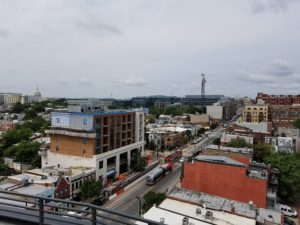 H Street Corridor
H Street Corridor
Image Credit: Author
The Development In Detail
Below is a map and detailed breakdown of all the development projects (greater than 20 units/20,000 SF) in the entire NoMa-H Street submarket that have delivered since 2005, are currently under construction, or are planned.
(We recommend clicking on the ‘box’ in the top-right corner to more easily view the map, and using the checkboxes and arrows on the left side of the full map to toggle different property types and find certain projects.)
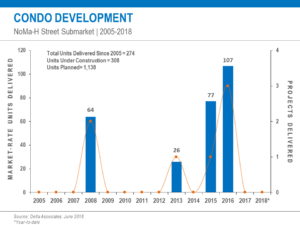 (Click Image)
(Click Image)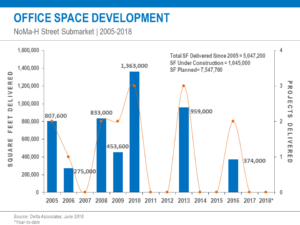 (Click Image)
(Click Image)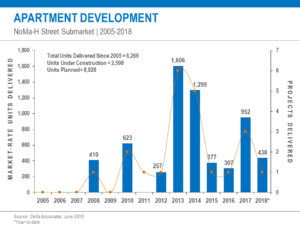 (Click Image)
(Click Image)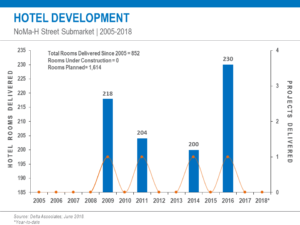 (Click Image)
(Click Image)
Why is NoMa One of the Fastest Growing Submarkets in the Region?
A. Access
NoMa is the single most accessible location in the entire Baltimore-Washington region thanks to a plethora of transportation options:
- Union Station-the second busiest train station in the nation and arguably the submarket’s most valuable asset with the following services:
- 11 Amtrak services, including the high-speed Acela Express to Baltimore, Philadelphia, NYC, and Boston
- 3 MARC and 2 VRE commuter rail lines
- the busiest station in the Metrorail system
- Intercity bus services provided by Greyhound, Boltbus, Megabus, and Peter Pan
- The NoMa-Gallaudet Metro Station
- The H Street Streetcar
- The popular Metropolitan Branch mixed-use trail
- Great highway access to the Beltway and eastern suburbs via US 50, and southern suburbs via I-395
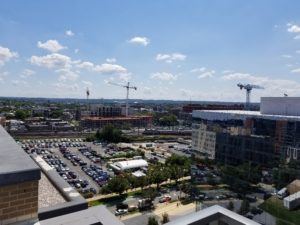 View of one the very few remaining vacant development sites remaining in NoMa (NoMa Station)
View of one the very few remaining vacant development sites remaining in NoMa (NoMa Station)
Image credit: Author
B. Blank Canvas
Unlike other more mature submarkets, redevelopment in the NoMa submarket has largely been relatively easy and straightforward. Prior to it’s redevelopment, NoMa was largely:
- vacant parcels
- surface parking
- industrial uses
- other readily redevelopable land.
C. Location
NoMa is very convenient to some of the most important and visited destinations in the District. The submarket is less than half mile from:
- The US Capitol and Supreme Court
- The National Mall
- The Walter E. Washington Convention Center
- The Penn Quarter entertainment district
- Howard University
NoMa’s Evolution from Office Park to Mixed-Use Destination
Originally, NoMa was envisioned as a primarily office-oriented submarket and park space was not planned in the neighborhood. Over time, market conditions changed and more multifamily development occurred, giving the area a more balanced aesthetic, but a lack of park space became a problem. A foundation set up by the NoMa BID called the NoMa Parks Foundation is correcting the planning error by purchasing land to build parks and working with developers to incorporate open spaces in their projects. NoMa’s evolution into a live-work-play neighborhood is well on its way.